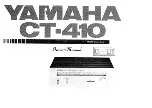
ADDITIONAL EXPLANATIONS
1. Squelch Circuit
In a receiver employing only a noise or carrier squelch, the squelch circuit is actuated and provides the
output whenever the receiver receives the same RF carrier as a receiving frequency. This causes even
a disturbing radio signal to be received provided its frequency is the same as the receiving frequency.
As a result, it can happen that sound is suddenly heard from the speaker due to disturbing radio signal
even when the wireless microphone's power switch is left OFF.
The squelch circuit of TOA's wireless systems consists of both the tone and noise squelches, and is not
actuated if only same RF carrier as the receiving frequency is received. It is so designed as to be
actuated and output a signal only when the received RF carrier contains a very exact pre-determined
tone frequency component. Therefore, disturbing radio signals are rejected and the speaker can be kept
completely quiet when the wireless microphone's power switch is set to OFF, ensuring reliable use in
every application.
2. Frequency Indicators
Component frequency ratings are expressed in combinations of alphabetic and numeric characters, with
letters substituted for all numbers to the left of the 1 MHz digit.
C = 160 MHz
D = 170 MHz
E = 180 MHz
All numbers to the right of the 10 MHz digit are still expressed as numerals.
Therefore : D5432 = 175.432 MHz
G7654 = 207.654 MHz
BLOCK DIAGRAM
CH 1 OUTPUT
—60dBV, 600
BALANCED
(XLR TYPE)
CH 2 OUTPUT
—60dBV, 600
BALANCED
(XLR TYPE)
MIXED
OUTPUT
(Phone Jack)
dBV, 600
ANT. IN
DISTRIBUTER
TUNER 1
TUNER 2
VR 1
VR 2
ATT.
0
dBV, 10k
F = 190 MHz
G = 200 MHz
H = 210 MHz
For example :
–7–


























